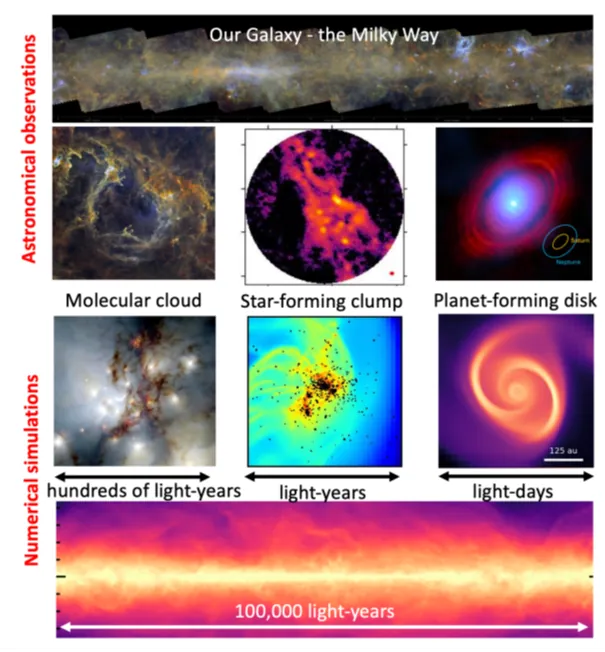
Unlocking Cosmic Secrets: The Dynamic Dance of Star and Planet Formation
2025-08-22
Author: Mei
A Paradigm Shift in Understanding Galactic Evolution
In a groundbreaking revelation, modern astronomy is transforming our grasp of how stars and planets come to be within galaxies. Recent studies highlight a shift from viewing these celestial bodies as existing in a static state to recognizing the vibrant and ever-changing nature of the interstellar medium (ISM) that fuels their creation.
From Simplicity to Complexity: The Universe's Evolution
The universe has experienced a remarkable journey since its inception around 13 billion years ago. Initially, it was a uniform expanse with only slight density fluctuations. Fast forward to today, and the cosmos has evolved into a stunning tapestry of structures, ranging from immense galaxy clusters down to individual stars and planets. Galaxies serve as the fundamental units of this cosmic architecture, making the study of their origins and evolution crucial for the field of astrophysics.
Emerging Insights on the Interstellar Medium
Historically, researchers viewed galaxies like the Milky Way as relatively stable ecosystems. However, new evidence indicates that the ISM plays a pivotal role in a much more dynamic and chaotic process of star and planet formation. This insight necessitates a comprehensive approach, considering the galaxy as a vast, interconnected system rather than a series of isolated components.
The Cycles of Matter and Energy in Galaxies
At the core of galactic development lies a continuous cycle of matter and energy governed by the ISM, characterized by turbulence and multi-phase flows. Stars originate from regions within the ISM that collapse under their own gravity, resulting in immense increases in density and temperature until nuclear fusion ignites, birthing new stars.
Forces at Play in Star Formation
Star formation is not a straightforward process; it is driven by a delicate balance of gravitational forces against opposing pressures like turbulence, magnetic fields, and radiation. Furthermore, the thermodynamic evolution of this gas is heavily influenced by its chemical composition and external radiation, making the interplay of these factors critical for understanding how stars come to be.
The Galactic Love Affair: Stars, Feedback, and Element Recycling
Star birth does not occur in a vacuum. Galactic dynamics, such as spiral density waves and interactions with satellite galaxies, also play critical roles. Feedback from newly formed stars—through radiation, stellar winds, and supernovae—not only shapes the ISM but also influences subsequent generations of star formation and the distribution of heavy elements essential for creating planets and complex molecules.
The Power of Multi-Wavelength Observations
Astrophysical research relies heavily on direct observations of the ISM, made possible by cutting-edge facilities like the Atacama Large Millimeter/submillimeter Array (ALMA) and the James Webb Space Telescope. The combination of various wavelengths and resolutions is vital for unraveling the intricate conditions across different galactic environments, revealing structures from the broad galactic disk to the fine details of planet-forming disks.
High-Performance Computing: Bridging Cosmic Scales
To fully understand the Galaxy's complexities, sophisticated numerical simulations are essential. Advances in high-performance computing now allow scientists to model diverse physical processes, accounting for gravity, turbulence, and chemical interactions. These simulations navigate the vast range of scales—from colossal galactic structures down to the origins of individual stars—using innovative adaptive techniques to focus on areas where star formation is occurring.


 Brasil (PT)
Brasil (PT)
 Canada (EN)
Canada (EN)
 Chile (ES)
Chile (ES)
 Česko (CS)
Česko (CS)
 대한민국 (KO)
대한민국 (KO)
 España (ES)
España (ES)
 France (FR)
France (FR)
 Hong Kong (EN)
Hong Kong (EN)
 Italia (IT)
Italia (IT)
 日本 (JA)
日本 (JA)
 Magyarország (HU)
Magyarország (HU)
 Norge (NO)
Norge (NO)
 Polska (PL)
Polska (PL)
 Schweiz (DE)
Schweiz (DE)
 Singapore (EN)
Singapore (EN)
 Sverige (SV)
Sverige (SV)
 Suomi (FI)
Suomi (FI)
 Türkiye (TR)
Türkiye (TR)
 الإمارات العربية المتحدة (AR)
الإمارات العربية المتحدة (AR)